Red
or white, dry or smooth, light or full-bodied, strong or delicate,
aromatic or fruity, Portuguese wines are without doubt one of the most
precious and appreciated treasures. It is possible to follow the wines
of Portugal routes and visit the regions where each type of wine has
been produced since time immemorial and get to know the local heritage
and its culture and traditions.
From the Minho region, lush
green and fresh, where the vinho verde vines grow on trellises, to the
terraces of the Douro, the oldest denominated wine area in the world,
and birthplace of the famous Port. Then travel to the lands of Dão and
Bairrada. The wine routes run through cities and towns full of history
and offer the best and truest parts of the Portuguese countryside.
More
to the south, near Lisbon, we have the wines of Bucelas and Colares,
precious and unique nectars. And along the Tagus river, planted in
fertile fields flooded by the river, are the wines of the Ribatejo. The
journey then heads south, where the Alentejo wine route extends through
the sun drenched plains. We finally reach the islands of Madeira and
the Azores. In the former, the king is of course the famous Madeira
wine and in the Azores, make sure you try Verdelho Wine, grown on
basalt rocks on the island of Pico.
- Vinho Verde
- Wines from the Douro
- Porto
- Wines from Dão
- Wines from Bairrada
- Wines from Ribatejo and West
- Wines from Colares, Bucelas e Carcavelos
- Wines from Tagus-Sado Peninsula
- Wines from Alentejo
- Wines from Algarve
- Madeira Wine
- Wine from the Azores
To know more:
Info Wine
Vinho Verde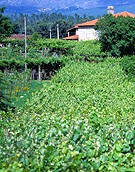
Vinho
verde, light and somewhat daring, is unique in the world, and is a
delightful excuse to get to know the Minho region. Ideal to accompany
fish and seafood or just as a refreshing pause on a hot day, vinho
verde is still a well-guarded secret and little known internationally.
Planted
on the Atlantic coast of the Minho region, in a steep sloping area, the
vines climb along trellises and border fields laced with characteristic
granaries. Moderately alcoholic and excellent for the digestion due to
its freshness and special qualities, the wine is very much appreciated,
especially in the hot season. Fermentation conveys an unmistakeable
flavour and personality. The reds are full-bodied, with an intense
colour - a rosy froth or vivid red, with the whites being lemon or
straw coloured.
The path through the Vinho Verde Route can start
in Caminha and Vila Nova de Cerveira, or the equally picturesque
Valença, on the edge of the Minho region. More to the north, Monção and
Melgaço are the centre of the most appreciated Portuguese green wine:
Alvarinho. Nearby is the Peneda-Gerês Natural Park, with villages in
the hills full of history and tradition, such as Castro Laboreiro and
Soajo.
Arcos de Valdevez, Ponte da Barca and Ponte de Lima owe
their names to the rivers which bring grace and freshness, as does
Viana do Castelo, in the Lima river mouth. You can also visit Barcelos,
near Cávado, and Braga, whose heritage evokes the ancestral roots of
the region. Another route leads to Guimarães, cradle of our nation and
a World Heritage site, along with Amarante, the beautiful city which
joins its river to its heritage.
Do not leave without a visit
to the regions emblematic estates, quintas, as famous for the houses of
their landlords as the qualities of their wines. Not to mention a visit
to Feiras Novas, the famous feast days at Ponte de Lima, which each
year celebrates the end of the harvests in September and where, in
between the feasting and the country festivals, the new wine is tasted.
To know more:
Knowing the Vinho Verde
Wines from the Douro
The
Douro region also produces white and red wines which for centuries have
lived in the shadow of the powerful Port Wine. However, these wines
have increased their quality and renown in the last fifteen years to
justify their denomination of origin status. The area extends
through the valley of the river Douro and its tributary streams,
including the districts of Vila Real, Bragança, Viseu and Guarda, and
the Douro denominated region of the same as that designated for the
production of Port, divided into three sub-regions -Baixo Corgo, Cima
Corgo and Douro Superior - with each of them producing wines with their
own specific features.
The whites include fresh wines, with
fruity and flowery aromas, with a great aromatic intensity, which
should be drunk when young. There are also whites which have fermented
or aged in wood, which are wines with complex aromas of tropical fruits
and almondy and creamy aspects, which are full-bodied and which can be
aged.
As regards the reds, of note are the young wines, with
cherry and raspberry flavours, rounded and ready to be drunk from the
moment they are bottled. The Douro Region also has a great tradition of
red wines which, when young, have an intense purple colour, with aromas
of black fruit, chocolate, violet and hints of wood, if this was part
of the ageing process. These are full-bodied brawny wines when young,
and become complex and delicate in their prime.
To know more:
Port and Douro Wines Institute
Douro Net
Porto Wine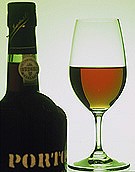
The
wine-growing valley of the Douro, classified as a World Heritage Site
by UNESCO, is also the oldest protected wine region in the world. In
1756 the Marquês de Pombal decided to protect the production and export
of a rare and special wine, grown on slopes which had been shaped into
natural terraces curving down to the river Douro. Port wine is today
one of the most well known and liked wines in the world and an
excellent calling card for those who wish to get to know Portugal. And
as a starting off point, surely there is nothing better than a tour
through the Douro, along the Port Wine Route.
This journey can
start in Oporto or in Gaia, where it is possible to visit the wine
cellars and try a glass of Port, then take a cruise upriver. It is also
possible to do this journey by car or by train, following the course of
the river, passing through magnificent countryside next to the estates
(quintas). In Régua, you can try the port in the warehouses along the
Docks. And in Vila Real and Lamego, it is worth doing some local
sightseeing. On the road to Pinhão, a magnificent sight awaits you in
S. Leonardo de Galafura.
On the mountainside, the river runs
between the steep slopes and piles of stones. This is the area of the
solares, of the Sanctuary of S. Salvador do Mundo, with a breathtaking
view of the almond trees in flower. A sight also not to be missed are
the grape gatherings in the Douro. They start in September and carry on
the whole month in a traditional routine which attracts ever more
curious visitors.
Port wine is a sweet and generous wine
and there are a number of distinct types and categories which are sold.
A Vintage label means a Port wine belonging to a single harvest of
declared quality, which, when tasted, at two years of age, is
full-bodied and full of tannins.<0}During the ageing in the bottle,
the colour remains strong, and there is a very distinct aroma and a
complex flavour of great persistency. It is very fruity with a complex
bouquet, which sometimes comes across as being resinous and ethereal.
Tawny
Port is obtained from a blend of wood aged port in small barrels or
vats of various ages. A compromise is obtained between the fresh and
fruity character of the young wines and the smoothness and toastiness
of a more marked ageing.
Port Wine with an indication of age is a
Tawny obtained by blending wood aged port of different ages, to produce
a balanced ageing corresponding to the average of the ages indicated
(10, 20, 30 and more than 40 years) During ageing, the young
aromas, fruity and fresh, change through an oxidisation process to
produce a «bouquet» which gives off a nutty, hazelnut, almond,
«vinegarlike», toastlike aroma of wood and spices.
Another type
of Port Wine shows the date of the vintage year (colheita). This is a
wine from a single harvest, wood aged for at least 7 years, in
conditions of extended oxidisation which gives it a clear gustatory
stability. An ideal ageing process will increase the smoothness,
harmony and viscosity, along with an increase in the complexity of the
«bouquet» and the aromatic persistence shown by the colouring mellowing
to a more golden brown, and showing the same greenish tendencies of
very old wines.
Late Bottled Vintage or LBV is a Port Wine from
a single vintage year of good quality. It is produced from selected
wines which are red and full-bodied. These wines have organoleptic
qualities which endow them with a high level of fineness and
distinction, being intensely fruity, full-bodied and smooth with the
aroma being decidedly fruity.
White Port wine is normally either
sweet or very sweet, and has a golden-white colour. The aroma and
flavour normally indicate a certain degree of ageing. There are also
wines which have a less intense maceration, which are generally dry and
extra-dry, with a pallid white colour and a complex flowery aroma,
which has been deprived of intensive oxidation so as to keep it as
fresh as possible. Then there is the light dry white, which is
different from the others as it is less alcoholic.
To finish, we
should mention Port Ruby wine. This is a young wine, which is red,
full-bodied and fruity, and obtained from a mixture of different
harvests and matured in large oak vats or tanks, so as to minimise the
loss of colour and aroma.
To know more:
Port and Douro Wines Institute
Port Wine Route
Wines from Dão
Dão
has been famous for its wines since the 12th Century, and there are
records to this effect testifying to the excellent of the wines
produced there. The Dão Wine Route begins in the area of Viseu, land of
granite and mountains. It then goes to the river Mondego, where the
countryside is greener, and sowed with vines, solares (manor houses),
quintas (estates) mixed in with the forests in the Serra do Caramulo.
Between
the Vouga and the Paiva there are thermal springs such as those of S.
Pedro do Sul, Roman temples and villages with shale roofs.
Dão
wines have an alcohol level of between 11 to 13%, and a pure velvety
flavour. The reds are ruby in colour and can be drunk with game, spicy
meat and with cheese. The white wines are suave, refined and aromatic
and are normally served with game, grilled meats or the strong cheeses
of the region.
To know more:
Comissão Vitivinícola Regional do Dão
Wines from Bairrada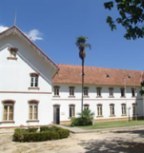
In
Bairrada, another place with a reputation for wine, the route visits
places as charming as the thermal springs of Luso and Curia, with their
gardens and hotels and Buçaco, one of the most beautiful and peaceful
places in Portugal. Near the coast, the lagoons and rivers give a
certain serenity to the atmosphere. Near the sea, which has left its
mark on the wines of Bairrada, you can find dunes and expansive
beaches, where the houses of Costa Nova, painted in colourful stripes,
are an attraction of their own.
The production of wines in
Bairrada was started by the Romans and continued at the hands of the
monks of the monasteries of Lorvão and of Vacariça, attracted by the
excellent natural conditions offered by the region, the soil of which
is made up of «bairros» ? black clay? which is from where the name of
the region derives. The quality and reputation of the wines from
Bairrada steadily grew throughout History to the point where, at the
end of the 18th Century, the Marquês de Pombal ordered the elimination
of most of the vineyards in Bairrada, as he feared that these wines
could provide competition to those from the Douro or that they would be
mixed in with the true Port wines.
In recent decades wine from
Bairrada has undergone a rebirth in terms of its prestige and quality
and today it is one of the key products of that region. The red wines
are characterised by their intense colour, their tannin quality and by
a fruity and marked aroma. The reds go through an ageing process which
is never shorter than 18 months and the main varieties are Baga,
Bastardo, Camarate and Jaen.
The Arinto and Bical
varieties are preferred for producing whites, which are characterised
by their golden tone, dry bitterness and intense flowery aromas.
As
for the sparkling wines, the most famous of Portugal, they must remain
in the cellar for nine months before reaching the market. Produced by
the classical method or fermented in the bottle, they are divided into
the Bruto, Seco or Meio-Seco categories according to how sweet they
are, and most belong to the Bruto category, which is characterised by
its flowery aromas and made with white and red grapes. The younger
sparkling wines have flowery or fruity aromas, while the older ones
give off aromas coming from the greater or lesser contact with the lees
from the second fermentation stage.
The sparking wine is the
ideal drink to accompany the delicious «Leitão à Bairrada» (suckling
pig), a characteristic dish from the region and one of the most
delicious in Portugal
To know more:
Regiao da Bairrada
Wines from Ribatejo and West
The
quality of wines from the Ribatejo is due to the fertile marshland
which from time to time is flooded by the waters of the Tagus river.
There, where bulls and horses graze, a special wine is produced which,
over the years, has obtained ever more fame and prestige.
In
Santarém, Cartaxo, Almeirim and Alpiarça, the wine is one of the local
riches, along with the Gothic monuments which remind us of the Golden
Age of the History of Portugal and the Tagus river, the soul of a land
of horsemen and bullfights. The wine has existed in this region for
several centuries and its fame reaches back to before the founding of
the country. D. Afonso Henriques mention the wines in the charter
granted to Santarém in 1170 and later, during the 14th and 15th
Centuries, a number of Portuguese monarchs, namely D. Pedro I, D.
Fernando, D. Afonso V e D. João II had the concern to protect the wines
of this region by prohibiting those from outside entering, or passing
other protectionist measures.
The particular characteristics of
the soils of the Ribatejo, the type of grape varieties used in the
region and the temperate sub-Mediterranean climate all play their part
to produce wines which very much have their own particular identity.
The Ribatejo wines, whites and reds, are smooth, velvety and fruity and
are increasingly prominent in the Portuguese wine catalogue.
However,
wine is also produced nearer the coast, to the West. Here is where we
find full-bodied red wines, lively, aromatic and with a precious
alcohol level when new and intense and balanced, with a rare «bouquet»
when older. The whites, in turn, are deliciously fruity. Try them while
also trying other pearls of the region, such as the fishing village of
Peniche, Cabo Carvoeiro, the Berlengas islands, or the medieval tourist
town of Óbidos, in a journey which forms part of the Western Wine
Route, which runs from the Ribatejo until the beaches of Santa Cruz or
Baleal.
To know more:
West Route
Wines from Colares, Bucelas e Carcavelos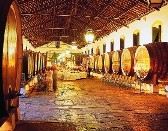
Near
to Lisbon there are three regions with a great tradition in producing
wine of a fine quality. These are wines from Bucelas, Colares and
Carcavelos. The first, the wines from which are located to the north of
Lisbon, an area still mainly rural, produces one of the best white
wines in Portugal.
Bucelas Wine became internationally well
known thanks to the French Invasions. General Wellington so appreciated
it that he took it as a present to the then Prince Regent, later King
George III of England. After the Peninsular War, this wine became a
habit at the English court. Bucelas wine, threatened with extinction a
short time ago, is nowadays a jewel of Portuguese enology. Very acidic
when young, and dry when old, it should be served with lightly seasoned
fish.
The reds of Colares, grown on one of the most
beautiful slopes of the green Serra de Sintra - classified by UNESCO as
a World Heritage Site - used to be considered the best in the country
and are nowadays protected at all cost. The unique characteristics of
Colares is due to the grape varieties, soil and temperate and humid
climate in summer, and, in addition, the fact that 80% of the vine is
located on a sandy ground, which extends virtually to the beaches.
The
red wine has a ruby colour and, with ageing, obtains a velvety and
exception bouquet. Colares wine only reaches its best quality after
some years, though the minimum period is 18 months. Given the long
ageing process necessary for the wine, commercialisation is limited,
and the region of Colares is a kind of sanctuary for those in the know.
Carcavelos
wine is one of the Portuguese wines with the greatest fame and the fact
that its production is very limited has made it a true rarity. The
Marquês de Pombal, who produced it from his Quinta (estate) in Oeiras,
appreciated it so much that he persuaded D. José I to offer it to the
court of Peking in 1752.
The region has a temperate
Mediterranean climate without major changes in temperature due to the
proximity of the sea, and Carcavelos produces a liqueur which is
delicate, with a topaz colour, and velvety with a certain almond aroma
and which acquires a marked and characteristic perfume with ageing.
Wines from the Tagus-Sado Peninsula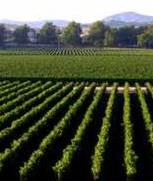
The
Arabs, a people closely tied to agriculture, stayed for some centuries
in the Tagus-Sado peninsula, and gave a great impetus to viticulture,
despite their religion not permitting the consumption of alcoholic
drinks. When the Kingdom of Portugal was established, the Franks came,
a people with extremely old wine-growing traditions.
In 1185,
when Palmela received its first charter, given by D. Afonso Henriques,
first King of Portugal, it mentioned the vines and wine of the region,
which confirms its wine-growing tradition. It is not known when the
growing of vines started in Arrábida, but it is known that the
Phoenicians and Greeks brought some varieties of grapes from the near
East which were planted here, as the climate along with the land on the
slopes of Arrábida, were considered amenable to the cultivation of
wine.
The Peninsula of Setúbal is indeed a pioneering region
in producing wine growing products of a recognised quality, as is the
case with the Moscatel from Setúbal, a generous wine whose area of
cultivation has been delimited since 1907 although it had been produced
for a long time previously. The Winegrowing Region of the Peninsula of
Setúbal is divided into three distinct categories: Palmela - D.O.C.,
Setúbal - D.O.C. and Terras do Sado - Vinho Regional. Mainly red grape
varieties are present in the region, with around 80% of the varieties
of wine, in particular in the council of Palmela.
The main
grape variety is the Castelão. However, besides other national grape
varieties, we have also seen the introduction of Chardonnay, Cabernet
Sauvignon, Merlot, Syrah, Cabernet Blanc, and Pinot noir and blanc,
amongst others. The white grape varieties most representative of the
Region continue to be Fernão Pires and the Moscatel from Setúbal, the
latter used for the generous wine of the same name.
In order
to get to know the Costa Azul Wine Route the ideal is to start by
visiting Palmela and then to head for the two towns of Azeitão, where
they produce some first class wines. Quinta da Bacalhoa is the first
stop, not only to try its wine but also to visit one of the most
beautiful Renaissance palaces in Portugal. The route then takes you to
the enormous Adega de José Maria da Fonseca, where you simple have to
try the magnificent wines produced there.
And make sure you
try the Moscatel of Setúbal, one of the delights of the region.
The «Moscatel» grape is grown in this region. The wine produced from
this grape is smooth and perfumed, like honey, on reaching five years
of age, and becomes even richer and more refined after 25 years. It
should be served as a digestif. Finish the tour with a walk in the
Serra da Arrábida, one of the most beautiful places in Portugal.
To know more:
Rota de Vinhos da Península de Setúbal / Costa Azul
Wines from Alentejo
The
planting of vines and the production of wine in the Alentejo goes back
to the Roman period, as traces dating from this period have shown,
namely fragments of grapes discovered in the ruins of São Cucufate,
near Vidigueira and some Roman wine presses. Located to the south
of the country, the Alentejo is a mainly flat region with some modest
relief features which still influence it in a noticeable manner. The
soils are varied, ranging between the granite of Portalegre, the
product of crystalline limestone of Borba, the Mediterranean greys and
reds of Évora, Granja/Amareleja and Moura, and the shale of Redondo,
Reguengos and Vidigueira.

The
Alentejo produces a large variety of high quality wines, with the white
wines being more important than the red wines. However, any of them
makes the ideal accompaniment to the delicious gastronomic specialities
of the region.
The white wines of the Alentejo are fruity,
lightly acidic and have intense original aromas; the reds have fresh,
fruity aromas or rich, smooth and balanced aromas. Amongst others, six
grape varieties separate them from other types of wine: three white
varieties - Roupeiro with a fine balanced aroma and a lemon tone, Rabo
de Ovelha, a variety which produces an open colour; Antão Vaz with a
unique and personal aroma. The three red varieties are Periquita, with
an agreeably fruity and smooth aroma; Trincadeira which denotes a
freshness and a suitable alcohol level; Aragonez, a heavy red coloured
variety, which gives body to its wines.
There is a controlled
Designation of Origin - DOC Alentejo, with eight winegrowing
sub-regions. The vines originally grew around settlements which were
later classified as towns or cities. Given the average area of these
vines, the wine growers decided to get together to form associations
and the first Agega Cooperativa appeared in Borba in 1958. Another five
adegas had been set up by 1972: Redondo, Portalegre, Vidigueira, Granja
and Reguengos, which brought fame to the wines of these regions and,
later on, helped to name the wine growing areas. Due to the tradition
and quality of their respective wines, another two sub-regions were
created: Moura and Évora.
To know more:
Wines from Alentejo
Wines from Algarve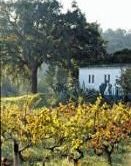
The
wine growing tradition of the Algarve was linked to the Moorish
presence in the region. This people both planted vines and also
exported the wine which was produced, with the Christians later on
taking advantage of this and expanding the economic activity
surrounding this product. From the second half of the 19th Century, and
with the development of viticulture in the region, its wines started to
occupy a more important place at the both the national and
international levels, due to their characteristics and quality. As a
designated wine growing region, with a characteristically Mediterranean
climate, and using traditional grape varieties to produce quality
wines, with a fruity flavour with low acid content increased by the
sun, the wines and spirits (aguardentes) took their place alongside the
gastronomic tradition of the Algarve.
Presently the winegrowing
region of the Algarve is divided into Lagos, Portimão, Lagoa, Albufeira
and Tavira, where in recent years new wine labels have appeared on the
market, with the most original being that of Cliff Richard.And if the
red or wine wines, whether table or sweet wines, are an essential part
of a good meal, do not also forget to have a medronho aguardente or
some other traditional liqueur made with fruits and honey. Monchique is
the aguardente region of the Algarve, which has such a special flavour.
Distilled in copper stills by centuries old techniques, it is normally
drunk in small sips, by men sat around a table, to show their
friendship and camaraderie. Another traditional taste from the Algarve
are the summer magustos of São Martinho, a time when recently collected
chestnuts are eaten and água-pé wine is drunk along with the new wine.
Madeira Wine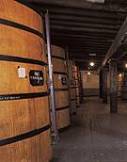
Appreciated
the word over, Madeira Wine is one of the ex-libris of that Atlantic
archipelago. Chosen to celebrate the Independence of the USA in 1776,
eulogised by Shakespeare, enjoyed by kings, princes, generals and
explorers, Madeira Wine is without a shadow of doubt a true treasure.
Although
there are more than 30 different grape varieties, the most prestigious
are: Sercial, Boal, Verdelho and Malvasia. Try them to get to know each
of them and, of course, to sample their different palates.
Secial
is the main dry one, ideal as an aperitif, as it is light and very
perfumed with a clear colour. Verdelho, delicate, quite perfumed and
with a golden colour, is the one to drink with meals. Half sweet,
suave, noble, velvety and with a dark golden colour, Boal is more
recommended between the roast and the dessert. Between meals or during
dessert few people can resist Malvasia. This is the incarnation of a
sweet wine, and full-bodied with an intense perfume and red colour.
Discover
how the soil and special climatic conditions of the island have
contributed to making the unequalled Madeira Wine. Wonder at the large
vineyards cultivated by hand, in small places where the ground is
supported by stonewalls on the slopes of the mountains. If you can,
visit Madeira in September and join in the grape gathering and the
Festival of Madeira Wine.
To know more:
Madeira Wine Institute
Wine from the Azores
Have
you ever thought of trying a wine which grew on a basalt rock? It
appears strange that such conditions could manage to produce such a
delicious nectar, but the truth is that the verdelho wine is so special
that for many many years it went directly to the table of the Czars of
Russia.
The Azorean wines have an intense and persistent
flavour, and have a surprising quality. We would highlight the Liqueur
Lajido, produced in the denotated region, with a history of kings and
czars going back to the 16th Century and a unique flavour which was
rediscovered a few years ago.
The growing of vines in the
Terceira, Pico and Graciosa Islands, which form part of the Archipelago
of the Azores, goes back to the time of their settlement in the
15th Century, with the thought that it must have been the
Franciscan Friars who were responsible for the introduction of vines
onto these islands.
According to some authors, these religious
brothers acclaimed the similarities between the edapho-climatic
conditions of Sicily and some of the islands of this archipelago, and
brought the most well known grape variety - the Verdelho (formerly
Verdecchio) from Italy and this rapidly took hold. The wines then
produced became famous. In 1917 bottles of Pico Wine were found storied
in the cellars of the former Czars of Russia.